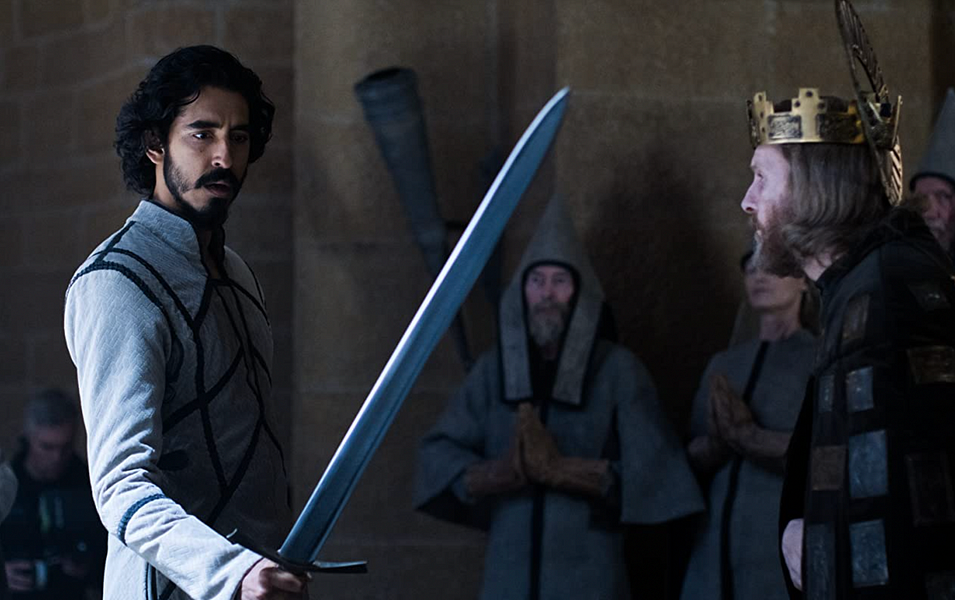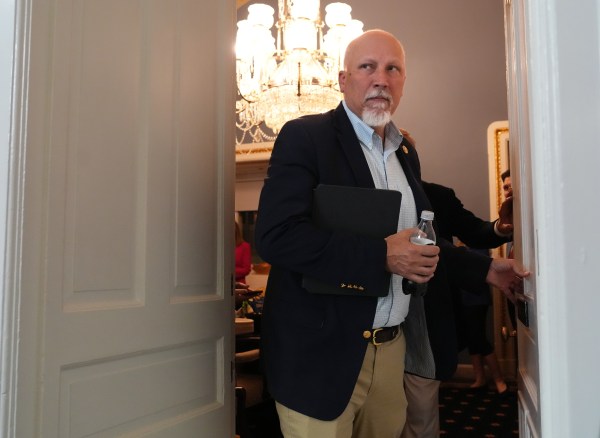In The Abolition of Man, C.S. Lewis wrote of a fundamental quandary facing modern Westerners: “We make men without chests and expect from them virtue and enterprise. We laugh at honour and are shocked to find traitors in our midst.” How, he asks, can we expect people to exhibit virtues which they have never been taught? How can we require honor from “men without chests”?
The 14th-century romance Sir Gawain and the Green Knight was written before the great deconstruction of Christian virtues in the modern mind. But the film adaptation, The Green Knight, could not be a more post-Christian, more 2021 story—for it is a film about honor full of men without chests, distributed to an audience that has been raised to disdain the search for greatness.
One might question whether in our society so full of quislings and tyrants it is really honor and chivalry that need debunking. But pushing that question aside, even to deconstruct honor meaningfully, a narrative must understand it. The Green Knight does not. Part moody fantasy and part impenetrable A24 art film,The Green Knight evokes honor culture only aesthetically, and thus it fails even at deconstruction, for it is impossible to effectively deconstruct a culture you do not comprehend.
The story begins on a snowy Christmas day, when the Green Knight (Ralph Ineson) bursts into King Arthur’s court. The knight bids some warrior to strike him down, and since—and this is a notable choice—Arthur (Sean Harris) is too frail and aged to take up the challenge, the king’s young nephew Gawain (Dev Patel) responds in his stead.
“Remember,” croaks the haggard legend, Arthur, “it is only a game.”
There is but one condition for this contest: The challenger must be willing to take the same blow he deals the Green Knight one year later, at the knight’s chapel in the forest. Gawain, not the world’s greatest long-term thinker, lops off the immortal knight’s head, thereby signing his own death warrant. Months later, having procrastinated in drinking and whoring, he begins an episodic and dark journey to meet his doom.
Despite its neglect of the interior worlds of its characters, The Green Knight excels at exterior worldbuilding. Its cinematography beautifully establishes a strange and hostile outside world glimpsed through the windows of claustrophobic dwellings. Gawain’s Britain is at once unmapped and very possibly unmappable. Giants and talking animals and haunted houses abound. Around every corner is something elemental and hostile. Nature is the antagonist, and man is the pest that entropy and time will exterminate.
This is dramatically and effectively evoked on screen—an impressive feat given the film’s slim budget of $15 million. And this middle section, as naïve squire Gawain stumbles from one perilous side quest to another, is the best part of the story. He lands in a version of the legend of St. Winifred, where he must help the headless lady to retrieve her skull. He meets a talking fox and encounters alarming scavengers on a smoking battlefield. The film threatens to be fun. But The Green Knight’s lack of interior worldbuilding and its grim tone drag it back into ponderous emptiness.
The film’s central problem is that it is about a quest—traditionally an archetypal series of moral tests illustrating the search for wisdom—but Gawain’s experiences never seem to amount to much of anything. Indeed, whether the quest itself is worth pursuing is very much up for debate. “Why do you need greatness? Isn’t goodness enough?” asks Gawain’s prostitute mistress, Essel (Alicia Vikander). A wise question, but one posed by a woman whose own character—both in personality and in virtue—is not clear. What does goodness mean to Essel? Presumably we’re supposed to fill in the blanks with our own ideas of goodness and greatness—and assume that the two are somehow inherently opposed. To seek greatness is inherently to disdain goodness.
This strikes me as a very modern, secular, and—trope-wise—female point of view that carries with it several unexamined assumptions. It’s not that this is a bad plot device, but it must be executed well. A a woman asking the hero to abandon his ambitious ways and commit to humble civilian life is a common trope in films critiquing honor culture.
The greatest treatments of the theme in American film are in classic Hollywood Westerns, which offer a valuable contrast to post-Christian myths like The Green Knight. (Indeed, in a sense the Western is the American Arthurian myth. Robert B. Pippin, paraphrasing “a German commentator,” writes, “the Greek had their Iliad; the Jews the Hebrews Bible; … the British the Arthurian legends. The Americans have John Ford.”)
The classic Western reveres the honorable man in the wilderness (while also being far more critical of the archetype than is commonly assumed—see The Gunfighter, The Big Country, The Searchers, etc.) It sees in him qualities of integrity and character, not simply a performative martyr complex.
This ethos could not clash more dramatically with modern mores. Many of the major on-screen stories of the last five years feature a beat where an ambitious male hero is humbled by a woman. Hamilton, The Greatest Showman, The Last Jedi, Minari, Enola Holmes, Loki, On the Rocks, Knives Out. I like and even love some of those stories, but the inherent badness of male ambition has become so axiomatic in modern storytelling that some films don’t even bother to explain why it is that this ambition is bad. In The Last Jedi, for instance, acts of derring-do by men are condemned while similar actions by women are lauded. The film never offers a plausible philosophy to distinguish between these actions. Similarly, The Green Knight shirks its responsibility to define terms.
John Ford’s Westerns offer an excellent contrast, clearly defining the terms and the values of the honor cultures they examine. In The Man Who Shot Liberty Valance, Ford portrays a town ruled by a cruel tyrannous outlaw who can only be ousted by a dangerous man cut from the same cloth—spurred by an eastern lawyer bearing the virtues of truth and courage. Competence and virtue are both necessary to achieve peace, though the conclusion also hints that civilization and the post-honor world can only be brought about by betraying the honor code. In this complex web of characters, Ford intends us to love both the civilized man and the honorable, uncivilized gunfighter, for each has his virtues.
In many Westerns, men motivated by martial virtues of honor, heroism—the values required in a violent state of nature—must be domesticated by women, who value commitment, politesse—the virtues of civilization. This is essentially the story of The Green Knight (sort of—there’s also plenty of symbolism in the rather muddy film that presents femininity as wild uncivilized Paganism). But while Ford sees the dark side of honor culture, he also recognized that there is something admirable in acts of great courage and willpower, in the courageous self-definition of a brave man in the wild.
Green Knight director David Lowery doesn’t offer us anything like this nuanced reflection on honor and civilization. For him, pursuit of honor is simply hedonism. There is no conception that with achievement of honor could come self-respect or even salvation. Gawain speaks of honor, but what does honor mean to him? Keeping a promise? Yes, this, at least. But dimly we intuit that there must be more to the virtuous life than simply winding one’s weary way to the doorstep of the grim reaper. Gawain does not start asking these questions until late in his plodding way.
The film’s treatment of Christianity is important in this calculus. “Christ is born” are the first words of the film, spoken in a brothel, a nest of hedonism and thoughtless lust. For Lowery, Christianity is simply shorthand for all that is safe and civilized and decadent. In an interview, Lowery said that Arthur is the only character to reference Christianity, and analogizes this to “rot at the heart of that court.” While Gawain is not an articulate hero, his conception of honor—the thing driving him out to finish his quest—is surely shaped by the Christian milieu of his youth. His desire to be a legend like his uncle is inspired by hearing of … the legend of his uncle, a Christian hero.
In paralleling Christianity and honor, the film is onto something. Christians are able to conceive of honor as the search for integrity, a quality which ultimately finds its only reward in God’s approval. “All I want is to enter my house justified,” says the protagonist in one of my favorite Westerns, Sam Peckinpah’s Ride the High Country. This line is meant to explain why the man pursues honor even against his own physical self-interest. And it echoes Christ’s parable of the humble tax collector, who, Christ says, “went down to his house justified” for he had pleased God. “All I want,” then, is to enter my Father’s house justified. If there is no God, then such honor-seeking really is mere vainglory. We should rather live practical, compromised lives that don’t take extraordinary risks for nonexistent spiritual rewards.
It is no surprise that the post-Christian Green Knight cannot conceive of spiritual rewards and does not think of honor-seeking in terms of integrity. Very modern, the film can see greatness only through the lens of oppression. Gawain’s striving for legendary status must really be a brutal, selfish process in which he gives little heed to those he leaves behind. His lust and vitality and ambition are the forces which propel him through the film.
To be fair, there is half of a good critique here. Using smuggled Christian virtues, Gawain comes to understand that the consequence of a hedonistic, nihilistic society (represented in the film by “red,” the color of lust) is death and horror (represented by “green,” the color of the plants that will one day blanket your bones). Abuse and unchecked desire lead to death—the wages of sin. The Green Knight, therefore, accurately diagnoses the problem (using Christian virtues that it does not name), but gropes blindly for a solution. Seeking something older, the ancient virtues—it can only find paganism, blood sacrifice, oblivion. Oneness with an uncaring natural world instead of hard-bought reconciliation with a loving god.
A Christian vision of humanity is profoundly different. Man is not simply an animal, subject to the same decay, violence and entropy as a fox or a tree. Man has an eternal soul and thus is part of a rich narrative in which, by exhibiting moral virtues, even at great cost, he can rise above the great mass of humanity living and dying mindlessly.
And in this great narrative, a man might even dare to live to be a legend. In The Green Knight, true honor is bought only through utter self-effacement. This is not to dismiss the possibility of an honorable death, but to acknowledge that embracing oblivion through death is not a virtue in a Christian honor culture. Death, after all, is not oblivion. It is not the final word. We are, at the end of the day, more than just our red passions or our green decay.
Kneeling before the knight’s axe, weak-kneed Gawain asks, desperately, “Is this all there is?” Christmas bells ring dimly in the background as if in answer.
But all we hear is the Green Knight, a kindly executioner, rumbling in response, “What else ought there be?”






Please note that we at The Dispatch hold ourselves, our work, and our commenters to a higher standard than other places on the internet. We welcome comments that foster genuine debate or discussion—including comments critical of us or our work—but responses that include ad hominem attacks on fellow Dispatch members or are intended to stoke fear and anger may be moderated.
With your membership, you only have the ability to comment on The Morning Dispatch articles. Consider upgrading to join the conversation everywhere.